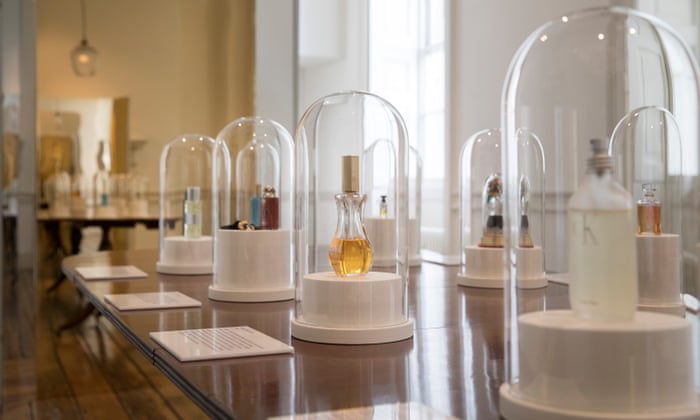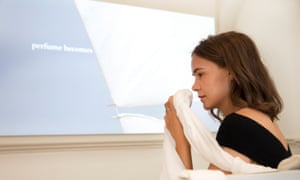
Iam on a road trip, somewhere hot and dry. Arizona, maybe, or Texas. I stop the car, open the door into the breeze and, while the cicadas play drums to the song on the radio, the roadside scents of grass and hot asphalt and petrol hit me full in the face. I can smell adventure.
I have never been to Arizona, or to Texas. It is 30C in London, and today’s adventures do not extend beyond the Victoria line. In real life, I am in one of the 10 installations in the new Somerset House exhibition Perfume: A Sensory Journey Through Contemporary Scent. Five minutes ago, in another room, I was picking up the smell that lingers on a sweater the morning after a campfire, along with all the anti-rat-race, acoustic-guitar baggage that goes with that. In another space, I close my eyes and it is as if I had stepped inside a quiet Mediterranean church on a July day: I can smell the wood polish, the dried flowers, but also, somehow, the cool of the stone, the soft clunk of the door closing the deep-pile hush that builds over centuries of whispers.

This is a revelation. Whatever the odour equivalent of being tone-deaf is, that’s me. I can just about recognise Chanel No 5 – the amount of money I’ve spent on it over the years, it would be fairly hopeless not to manage that – but there is almost no other scent I can pick out in a line-up. To me, most perfumes smell … nice?
Yet this doesn’t stop me wanting new perfumes, and that fascinates me. I was once obsessed with Robert Piguet’s Fracas, which smells like the person you most want to talk to in a room. Currently, I am obsessed with Estée Lauder’s Bronze Goddess, which is the smell of summer holidays. I have zero connoisseurship – I couldn’t tell you what ylang ylang smells like if my life depended on it.
I am not even sure I could recognise the smell of rose – so the fact that I am still moved by fragrance suggests that its meaning goes way beyond smell.
Claire Catterall, curator of the exhibition, describes perfume as “the most democratic form of art.” In collaboration with fragrance writer Lizzie Ostrom, Caterall attempts to free perfume from the opaque language of “top notes” and “dry downs” and dig into our thought processes around perfume. “Perfume has everything: it’s about our art, and commerce. It’s about intimacy and relationships and our place in the world,” says Catterall. “It’s about hopes, aspirations, memories and emotion.” The installation for Secretions Magnifique, an infamous decade-old scent by perfumer Antoine Lie, features a rumpled bed on which visitors are invited to sit, and sniff the fragrance embedded in the sheets. The notes of the perfume include semen, blood, sweat, saliva and breast milk. “It’s about the whole journey of love,” says Catterall.
The story of scent is the story of culture. Jose Eisenberg, founder of luxury fragrance house Eisenberg Paris, says fragrance is “the reflection of a particular society and period of time. Patchouli is a symbol of femininity, and represents the 70s days of women’s liberation, hope, optimism, freedom and a new fraternity between peoples. The salty-clean 90s scents conveyed the desire to get rid of the previous decade’s excess. To purify the world.”

The narrative is told visually, as well as in the “juice” itself. The packaging of 90s favourite CK One looks like a bottle of Absolut Vodka. The uncanny ability of Chanel No 5 to keep smelling modern is echoed in the design, which at nearly a century old has the up-to-date proportions of an iPhone 6.
What we desire and value as consumers in the marketplace cannot be separated from what we desire and value as human beings in society. The millennial appetite for experience over possession; the modern emphasis on authenticity (a subtly different value than loyalty or constancy); the 21st century’s more nuanced perspective on gender: all of these are reflected in the fragrances we buy. The new wave of fragrances that are radical rather than pretty, which transport you to a hot roadside, or a cool church, or the morning after a campfire – are, quite literally, the essence of paying for an experience. The Salons de Parfums, modelled on upscale boutiques, opened two years ago at Harrods to reflect consumers’ desire for a more intense, experiential shopping journey.
Melissa McGinnis, Selfridges’ beauty-buying manager, reports “a much more intrepid shopper looking for depth, range and, most importantly, individuality through fragrance”. Specialist, independent, niche fragrance brands account for about 45% of perfume sales at Selfridges.
The modern perfume shopper is not looking for an established perfume with which to identify, but looking for the scent – or bespoke or layered scents – that reflect their identity. In the modern world, the personal brand is the most important one. Meanwhile, our short attention spans have killed off the once holy-grail of the signature scent. “It’s not so much about one or two fragrances on the bathroom shelf any more,” says Annalise Ford of Harrods. “It’s about five, or 10 – a fragrance wardrobe.”
“Gender is irrelevant in modern perfume,” says Catterall. The days when fragrances for women came in hourglass-shaped bottles and those for men in tins the shape of WD40 are over. Many of the fragrance brands at Selfridges “present as personality- rather than gender-led,” says McGinnis. “They are moving away from the notion of what is typically masculine or feminine in scent.”
At the moment, says Ford, there is a trend for what she calls “emotionally protective” fragrances. “Herbaceous notes such as mint, cucumber and lime feel like a reaction against the uncertainty of the outside world.” In the same way we crave those flavours on a hot, frazzled day, we crave the scents. “Buying perfume isn’t just about wanting to be sexy or sophisticated any more,” says Ostrom. “Things have got a bit more complicated than that.”
[“Source-theguardian”]
